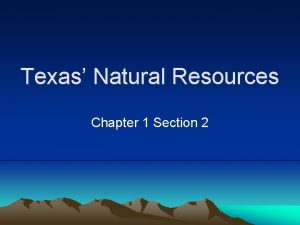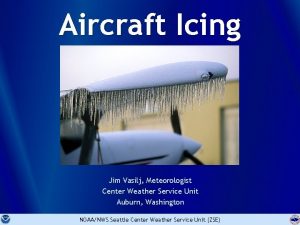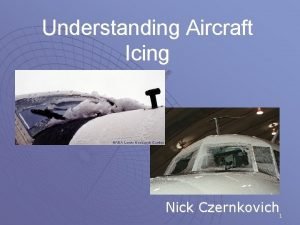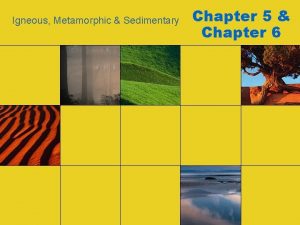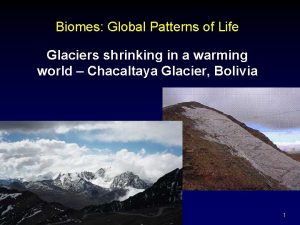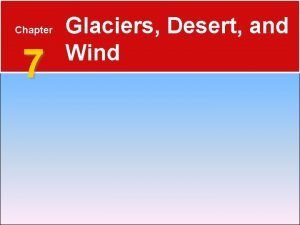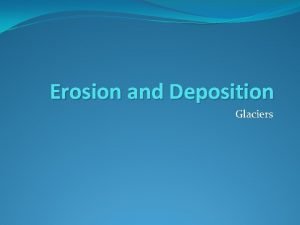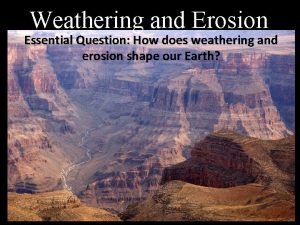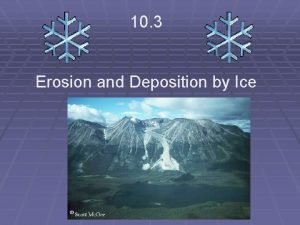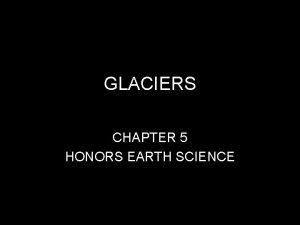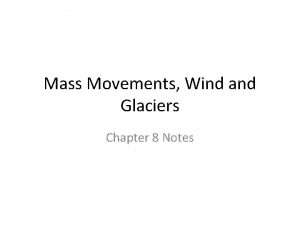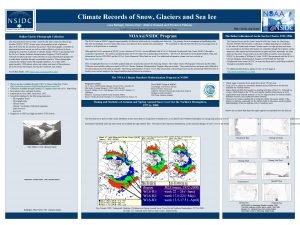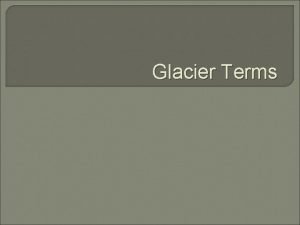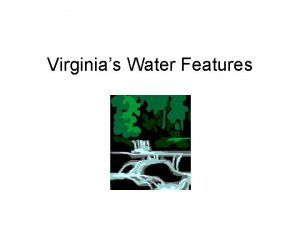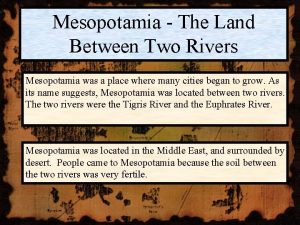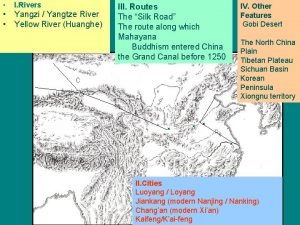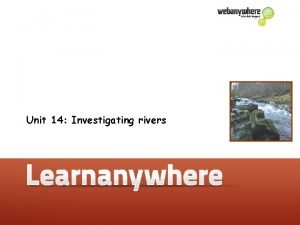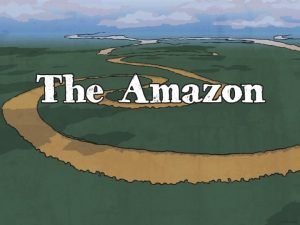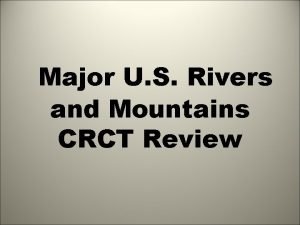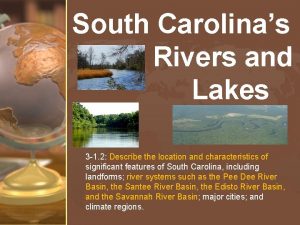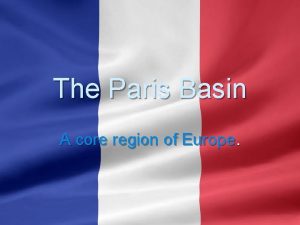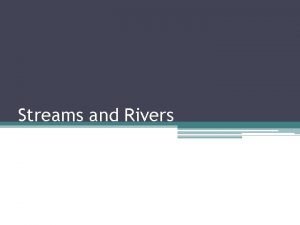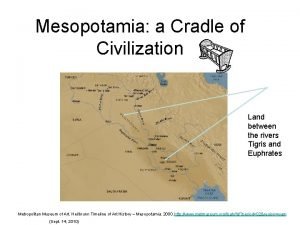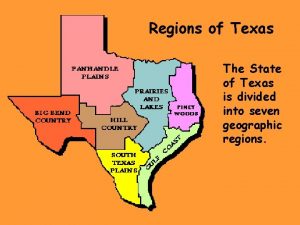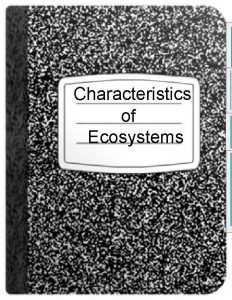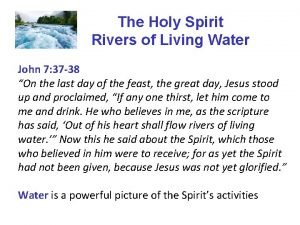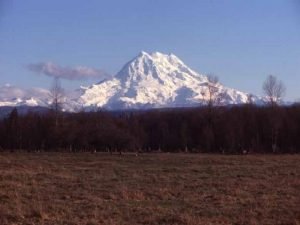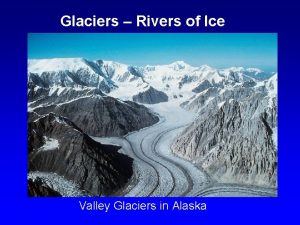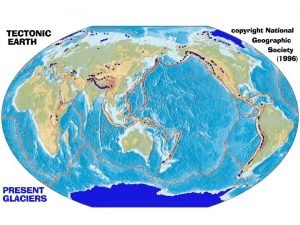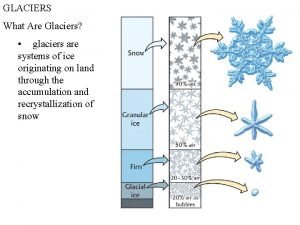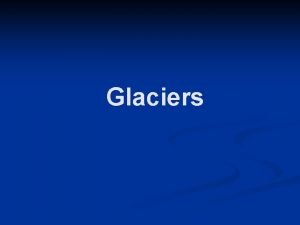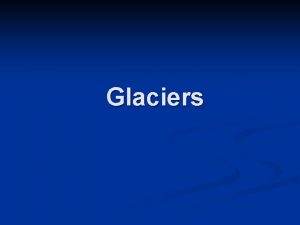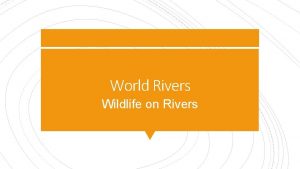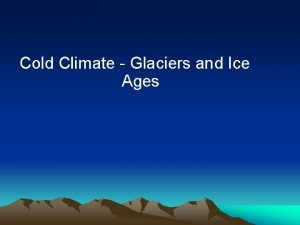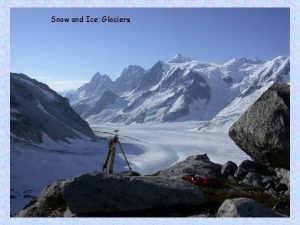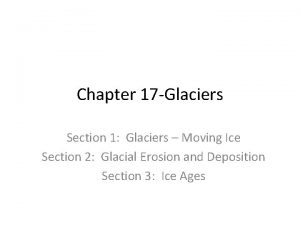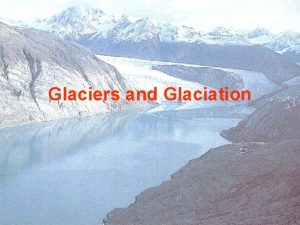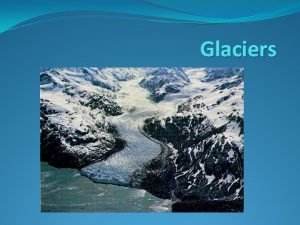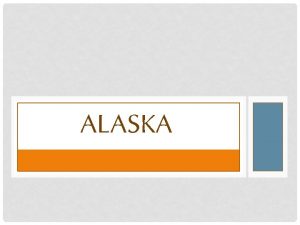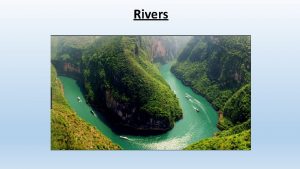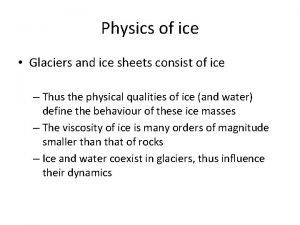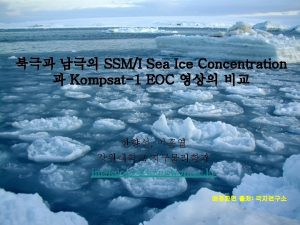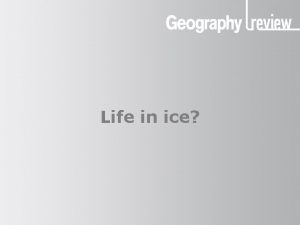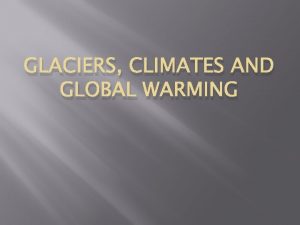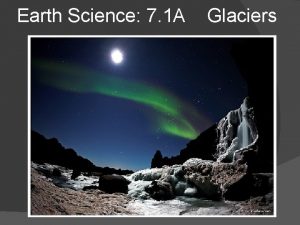Glaciers Rivers of Ice Valley Glaciers in Alaska






































- Slides: 38

Glaciers – Rivers of Ice Valley Glaciers in Alaska

Why study glaciers? • Glaciers cover ~10% of Earth’s surface - the • • polar ice sheets account for most of this. Approximately 85% of Earth’s fresh water is stored as glacial ice. There have been numerous “ice ages” in the past, what about the future? They respond to modern climate changes. In many areas agriculture takes advantage of the fertile soil deposited by glaciers during the last ice age.

Why study glaciers? Remember – Only about 3% of Earth’s total water budget is fresh water.

Glaciers – Rivers of Ice • What is a glacier? • What are the types of glaciers and how do • • they form? How do glaciers flow? How do glaciers erode, transport, and deposit sediment? How do glaciers modify the landscape? What causes the ice ages?

What is a glacier? • A glacier is simply an accumulation of snow and ice that is thick enough to flow downhill under its own weight. A valley glacier in the Swiss Alps.

What are the types of glaciers and how do they form? • There are three types of glaciers: • Valley glaciers - long, narrow glaciers that are confined to valleys and flow downhill much like streams. • Ice sheets - unconfined glaciers larger than 50, 000 km 2. There are two ice sheets on Earth today, they are in Greenland Antarctica - these are continental scale glaciers. • Ice caps - unconfined glaciers that are smaller than ice sheets. Both ice sheets and ice caps may exhibit radial flow and have valley glaciers exiting them.

What are the types of glaciers and how do they form? • Where do glaciers form? • Anywhere snow persists all year, thus cold-climate areas, or high altitudes. High altitudes where temperatures are colder than the surrounding, lower elevation areas. High latitudes where seasons are colder. • Heavy yearly winter snowfall is essential. • Snowline: the elevation above which snow persists throughout the year.

What are the types of glaciers and how do they form? Valley Glaciers in Alaska

What are the types of glaciers and how do they form? Valley glaciers are usually 50 -300 meters thick.

What are the types of glaciers and how do they form? The Antarctic ice sheet glacier (>50, 000 km 2 ) is up to 4 km thick and covers the entire continent.

What are the types of glaciers and how do they form? Ice cap glaciers (<50, 000 km 2 ) are much smaller and cover, e. g. , local mountainous areas. Fig 18. 3

What are the types of glaciers and how do they form? • Snow “metamorphism” – snow becomes ice (i. e. it metamorphoses) at temperatures and pressures on the Earths surface. • Snowflakes compact and turn into rounded ice grains due to the weight of snow accumulating year-round. • Rounded ice grains continually recrystallize into denser ice crystals over time due to burial and increased pressure. Pore space is diminished. • The end result is interlocking ice crystals with a density of ~0. 9 gm/cm 3 (close to that of water).

What are the types of glaciers and how do they form?

How do glaciers flow? • Glacial ice behaves like weak rock. • Ice has cleavage (much like micas) and when stressed, ice crystals slip along the cleavage planes by plastic deformation. • This occurs at a few tens of meters depth, typically ~50 m. • The upper reaches are brittle. • Thus, there is a brittleductile transition in glaciers. The lower parts flow like very thick toothpaste.

How do glaciers flow? <50 m brittle fracture and crevasse formation >50 m internal flow and plastic deformation

How do glaciers flow? At higher elevations - the zone of accumulation, where winter accumulation exceeds summer melting. At lower elevations - the zone of wastage, where summer melting exceeds winter accumulation. The snowline separates the zone of accumulation from the zone of wastage.

How do glaciers flow? Glaciers flow from the zone of accumulation to the zone of wastage due to mass increase in the zone of accumulation. If overall accumulation exceeds wastage then glaciers advance. If overall wastage exceeds accumulation then glaciers retreat.

How do glaciers flow? Glaciers move fastest in the center, away from the bottom and sides. Glaciers may either slide along at their base, or not. Plastic flow dominates in the latter case.

How do glaciers flow? • The bottom temperature of a glacier controls whether it slides or not, and sliding equals more erosion. • If the base is frozen solidly to the rock then little motion can occur along the base. Motion is accomodated by plastic flow internally within the glacier. • If the base is at or above the melting temperature, then liquid water may exist there. • Water acts as a lubricant, reducing cohesion and friction. • Water is pressurized by the weight of the overlying ice. Water pressure at the base of some glaciers is nearly equal to the weight of the overlying ice. The glacier basically slides along on this thin layer of water. Internal plastic flow is diminished in this case.

How do glaciers flow? In the upper brittle zone crevasses may form. These generally form where the glacier overrides higher areas of bedrock. Crevasses are the surface expression of changing velocities.

How do glaciers erode, transport, and deposit sediment? • Glaciers are “rivers of ice”, they flow downhill, eroding, • • • transporting and ultimately depositing sediment. Glacial landforms are produced by these processes. Glaciers exert very large shear stress on the rocks they flow over – due to the very large mass of thick ice. Thus, the erosional capacity of glaciers is many times greater than that of even the largest rivers. Freeze-thaw cycles cause glacial ice to attach to rock and pluck it off as the ice moves downhill. Plucked rock fragments act as an abrasive in the ice, further eroding the rock the glacier passes over - glacial striations.


How do glaciers erode, transport, and deposit sediment?

How do glaciers erode, transport, and deposit sediment? Moraines are formed by the “bulldozing” action of moving glaciers.

How do glaciers erode, transport, and deposit sediment? Till is sediment directly deposited by the glacier. Cobbles often have Outwash is sediment carried away by meltwater from a glacier. flat edges and striations.

Glacial Till Forms Moraines Large Lateral Moraines - Sierra Nevada Mountains

How do glaciers modify the landscape? • In some areas glaciers are the dominant force for creating the landscape, especially in high, cold, mountainous regions and high latitude areas. • Ice-age glaciers produced many of the landscape features over large areas of North America and northern Europe in areas that are now ice-free.

The five main glacial landscape features. Moraines – a depositional feature already discussed. Important erosional features are: 1) U-shaped valleys 2) Cirques 3) Knife edge ridges and pointed peaks 4) Hanging valleys

How do glaciers modify the landscape? A view of Alaska's Athabasca Glacier.

How do glaciers modify the landscape? A U-shaped valley. When sea level rises into a U-shaped valley, the result is a fjord.

How a U-shaped valley is produced. Erosion is highest in the center where velocity is the fastest and ice thickness the greatest, resulting in the Ushaped profile over time. Fig 11. 29

Hanging valleys are produced by more rapid erosion in the main glacier channel versus tributary channels, causing a large vertical difference between the channels once the glaciers melt.

What causes ice ages? • The most likely explanation – variations in Earth’s orbital parameters. • The poles receive more summer sun and less winter sun when the axial tilt angle is high. The tilt changes with time. • The Earth-Sun distance changes due to variations in the eccentricity of Earth’s orbit. • The tilt and eccentricity, along with another parameter called precession, occur over different timescales, and thus may have an additive or subtractive effect (modulation) at any point in time. This can be precisely calculated.

What causes ice ages? Variation in axial tilt occurs over periods of ~40 ka.

What causes ice ages? Variation in orbital eccentricity occurs in periods of ~100 and 400 ka. Another orbital parameter called precession has a period of ~23, 000 years.

What causes ice ages? The timing and relative effect of orbital variations (Milankovich cycles) and their relation to the ice age record.

What About More Recent Warming? The Portage Glacier in Alaska has receded dramatically in the past ~100 years.

What About More Recent Warming? This is seen in glacial landscapes worldwide, it is not a local event…. These changes are occurring over periods of <100 years, much quicker than glacial cycles driven by Earth’s orbital cycles.
 Why are some rivers in texas called “wrong way” rivers?
Why are some rivers in texas called “wrong way” rivers? Clear ice vs rime ice
Clear ice vs rime ice Tat sat temperature
Tat sat temperature Landslides moving water wind and glaciers cause
Landslides moving water wind and glaciers cause Bolivia glaciers
Bolivia glaciers Chapter 7 glaciers deserts and wind
Chapter 7 glaciers deserts and wind Terminal moraines
Terminal moraines Glaciers cause erosion by abrasion and
Glaciers cause erosion by abrasion and What are the two main types of glaciers
What are the two main types of glaciers Morraine glacier
Morraine glacier Buffalo ridge minnesota
Buffalo ridge minnesota Examples of mass movement
Examples of mass movement Nsidc glaciers
Nsidc glaciers U shaped valley
U shaped valley Important water features of virginia
Important water features of virginia Profited from location on major rivers
Profited from location on major rivers What 2 rivers surround mesopotamia
What 2 rivers surround mesopotamia Scribes
Scribes I rivers
I rivers Only when all the rivers have run dry
Only when all the rivers have run dry Rivers
Rivers Lateral thinking riddle
Lateral thinking riddle Label the seine thames elbe tiber and danube rivers
Label the seine thames elbe tiber and danube rivers Investigating rivers
Investigating rivers Rivers passing through sherwood forest
Rivers passing through sherwood forest Major us rivers
Major us rivers 7 rivers alliance
7 rivers alliance South carolina rivers and lakes
South carolina rivers and lakes Paris basin sketch map
Paris basin sketch map The land between two rivers
The land between two rivers Types of bodys of water
Types of bodys of water Land between rivers
Land between rivers Asperro
Asperro Texas map with cities and rivers
Texas map with cities and rivers Interlocking spurs definition geography
Interlocking spurs definition geography Land between rivers
Land between rivers Bill nye rivers and streams answers
Bill nye rivers and streams answers Longest rivers in china
Longest rivers in china Holy spirit rivers of living water
Holy spirit rivers of living water
